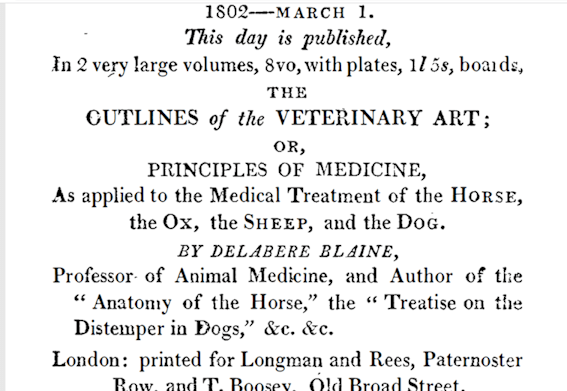My Pride & Prejudice sequel, ‘Menace At Pemberley’ set in 1798/1799, includes incidents of dog-poisoning and I wanted to find out what means of diagnosis and, if relevant, treatment would have been available. My husband was convinced that someone of Darcy’s stature would have had the means to employ experts to ascertain the cause of the dogs’ deaths, that there must have been experts whom Darcy could employ. I doubted that this was the case and indeed his assumption turned out to be quite wrong.
I was lucky enough to come across a long work whose short title was ‘A Domestic Treatise on the Diseases of Horses and Dogs’ by Delabere Blaine, Veterinary Surgeon, Professor of Animal Medicine and author of a number of works on animals and animal diseases. It was first published in about 1802 and was subsequently added to. Delabere Blaine was one of the first students of the Veterinary College of London founded in 1791.
The Treatise referred to above was said to have been written with the express purpose of providing information on veterinary medicine because ‘even large towns have no regular veterinarian while smaller towns, villages and the country at large are all of them deprived of any other assistance than what can be gained from the neighbouring smith’.
One has to go to page 237 of the Treatise to learn that the most common poison is the vegetable called crow fig, which produces its deleterious effects by robbing the nervous system of all its energy in a few minutes. The treatise refers to the experience of Professor Blaine of having witnessed the death of a very strong Newfoundland dog destroyed in five minutes by half a dram of crow fig.
Crow fig is said in English to be the name of a plant ‘defined with Strychnos nux-vomica in various botanical sources’, what we would probably call strychnine.
The Treatise also tells us that, at least at that time: ‘Dissection cannot detect this poison with any certainty; and unless an emetic is given within three minutes after the poison has been taken, provided the dose has been a full one, no benefit will arise from any medicine.’
I only provide the above details because it illustrates how much research can be necessary to answer seemingly simple points, in this case how would dogs be efficiently poisoned in 1798 and whether it would have been possible to effectively establish the reason for their deaths. It is just one example of the extent of research necessary to produce a reasonably accurate and authentic novel. It goes to show that one cannot, as a writer, make assumptions (or rely on one’s husband’s assumptions!).


Recent Comments